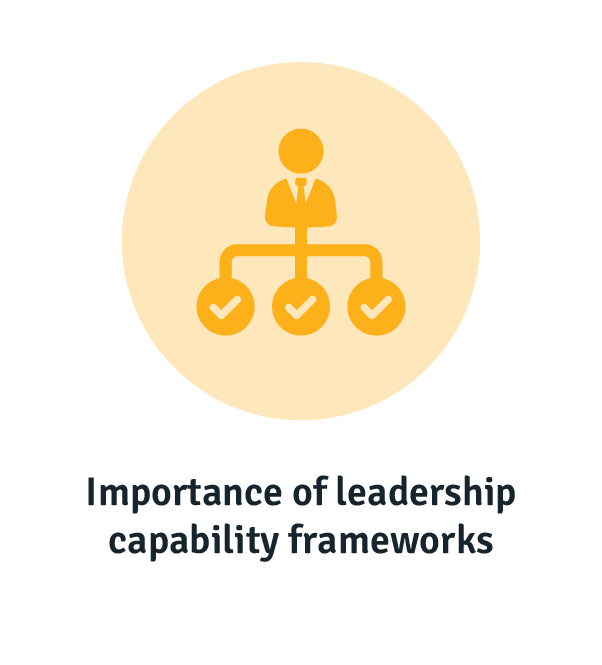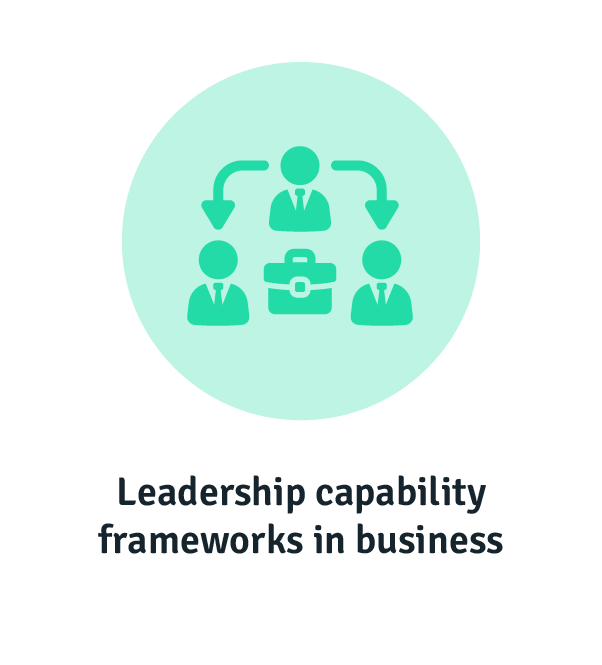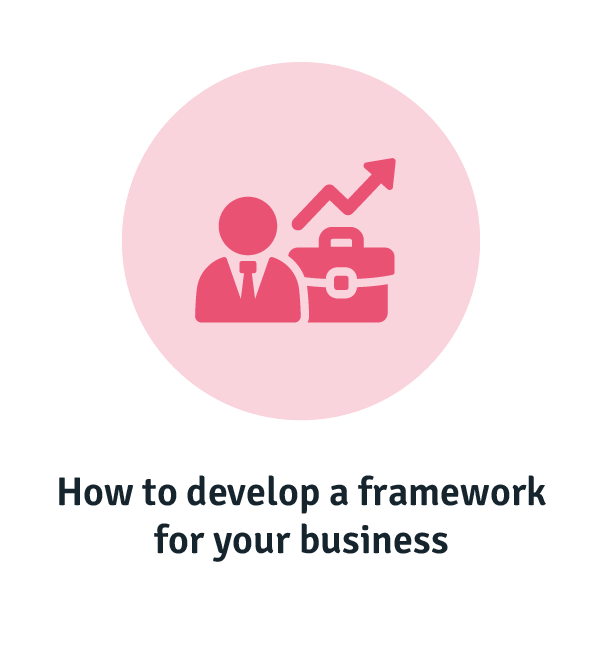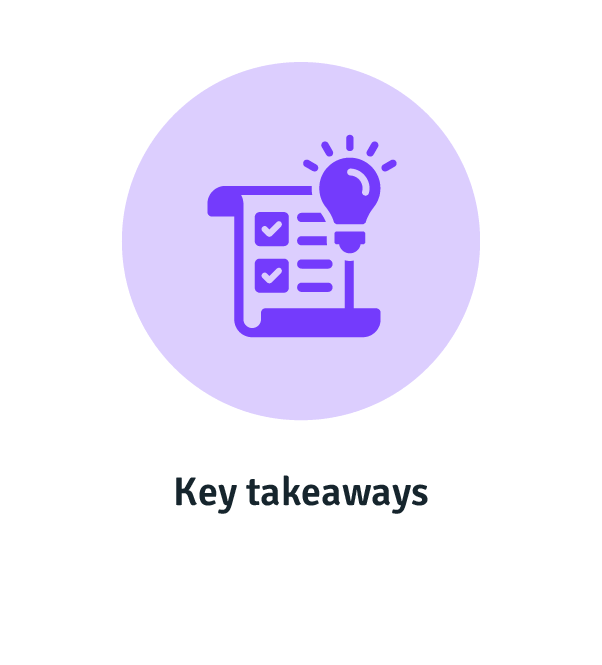Why You Should Use a Leadership Capability Framework When Developing Leaders
Few things in talent management can be as important as developing future leaders in a manner that’s structured for your organisation’s requirements. If you’re investing in a future leadership program, you’ll want to have a basis for ongoing assessment and management. That’s where the leadership capability framework comes in.
Where your organisational capability framework speaks to all employees regardless of title, a leadership capability framework is the most reliable way to gauge leadership potential and guide burgeoning leadership skills.
In this guide, we’ll walk through the purpose and some key elements of a leadership capability framework, its points of difference with other frameworks, and how to implement one in an established organisation.
What is a leadership capability framework?
A leadership capability framework outlines the capabilities required in leaders in order to achieve key business objectives. It creates a common language around what “good” and effective leadership looks like in an organisation, making it a unique and exclusive framework to your business.
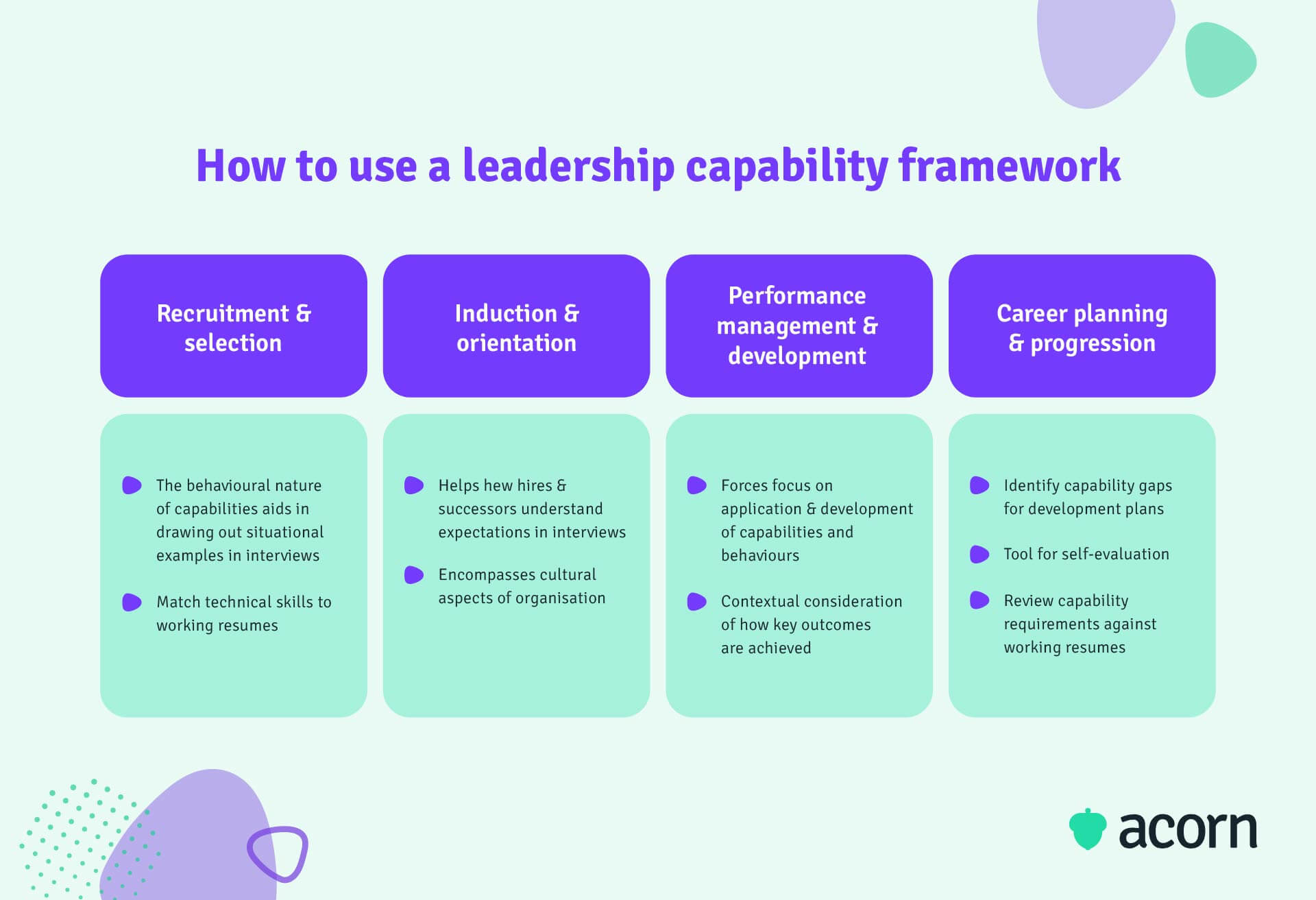
Why it’s important to have a leadership capability framework
It’s as simple as considering how:
- External changes can bring new skills to the forefront and outdate others, even with continuous learning opportunities.
- The job market can flip rather easily between being a job seeker and employer market, meaning talent can be scarce at any time. (Which affects everyone from agencies to enterprises.)
- A lack of available talent or misinformed talent choices can force budding leaders (at best) and ill-prepared or unwilling individual contributors (at worst) to assume responsibilities much faster than usual.
But of course, we wouldn’t miss the chance to dive a little deeper into the importance of having a framework for leadership capabilities (and capability development). There is a common thread with all of these business risks: A lack of assessment. That’s assessing your external environment, analysing your internal talent needs, and knowing how to measure one against the other.
This is partly why you’ll want a framework that defines good leadership and supports a pipeline of emerging leaders. View a leadership capability framework as a map for a leadership development program. It supports and informs:
- Performance management & feedback
- Capability assessment and gap analysis
- Building capability in line with business strategy
- Analysis of training needs
- Talent management & succession planning
There are three specific ways in which leadership capability frameworks are beneficial.
- Assessing leadership potential
- Managing ongoing leadership capabilities
- Giving strategic weight to learning and development (L&D).
On that last point, most corporate learning approaches are broken. They focus on skills (that expire quickly) and throwing more content at learners than they know what to do with. This thinking puts time-poor leaders and emerging leaders into potentially irrelevant training experiences.
We created a performance learning management system (PLMS) for this reason. It links the leadership capabilities to the specific capabilities needed to excel in a role (or to move into a role). Within the PLMS, you can then create truly tailored and contextual learning opportunities, enabling you to definitively measure performance improvements and identify desired capabilities for promotion.
Why is it critical to assess leadership potential?
A leadership framework allows you to evaluate talent for promotion and development using markers of skills and proficiency. Without one, selection can be a highly subjective process or based on past performance rather than future capabilities.
High-achieving individuals don’t always have great people management skills right out of the gate, least of all because individual contributors are responsible for themselves and to others. A good pick could go unnoticed (and eventually leave out of attrition) without a way of assessing leadership capability.
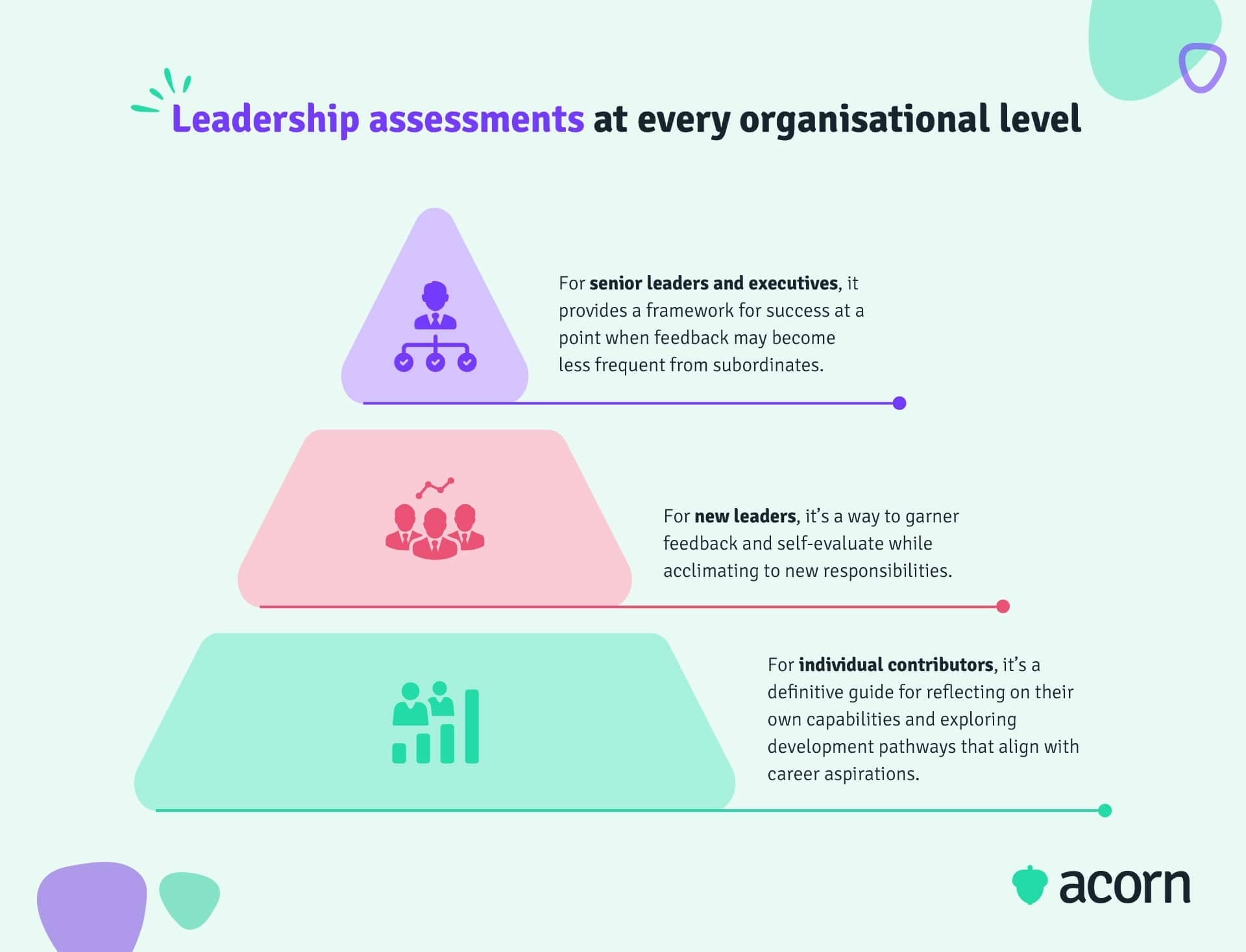
A leadership framework further enables better self-awareness as much as it does good feedback. Closing the gap between perceived performance and actual impact means you’ve got more effective leaders, who are the lynchpins to a high-performing organisations.
In another way, leadership deficits can appear as an organisation grows. Companies with a young workforce just beginning in their careers may find the jump from start up to market disrupter shaky without a leadership framework. Studies have shown that while important among leaders, leadership talent doesn’t often make a difference to their performance—capabilities do. Ergo, identifying potential and developing capabilities is your best bet for assessing leadership prospects.
Why do you need to manage leadership?
A promotion to the corner office is rarely where the path ends in terms of leadership development. Sure, it’s a validation of an individual contributor or junior manager’s appropriate (though not necessarily perfect) set of capabilities. But excelling in one role is not precedent for succeeding in another with more responsibilities and challenges.
It’s an oft-quoted cliché that people don’t leave companies, they leave managers. Research has shown that in “bad” companies, managers (good or bad) make little difference—but leadership makes a world of difference at “good” companies. Which brings us to the difference between managers and leadership, and why leadership capabilities are important to develop.
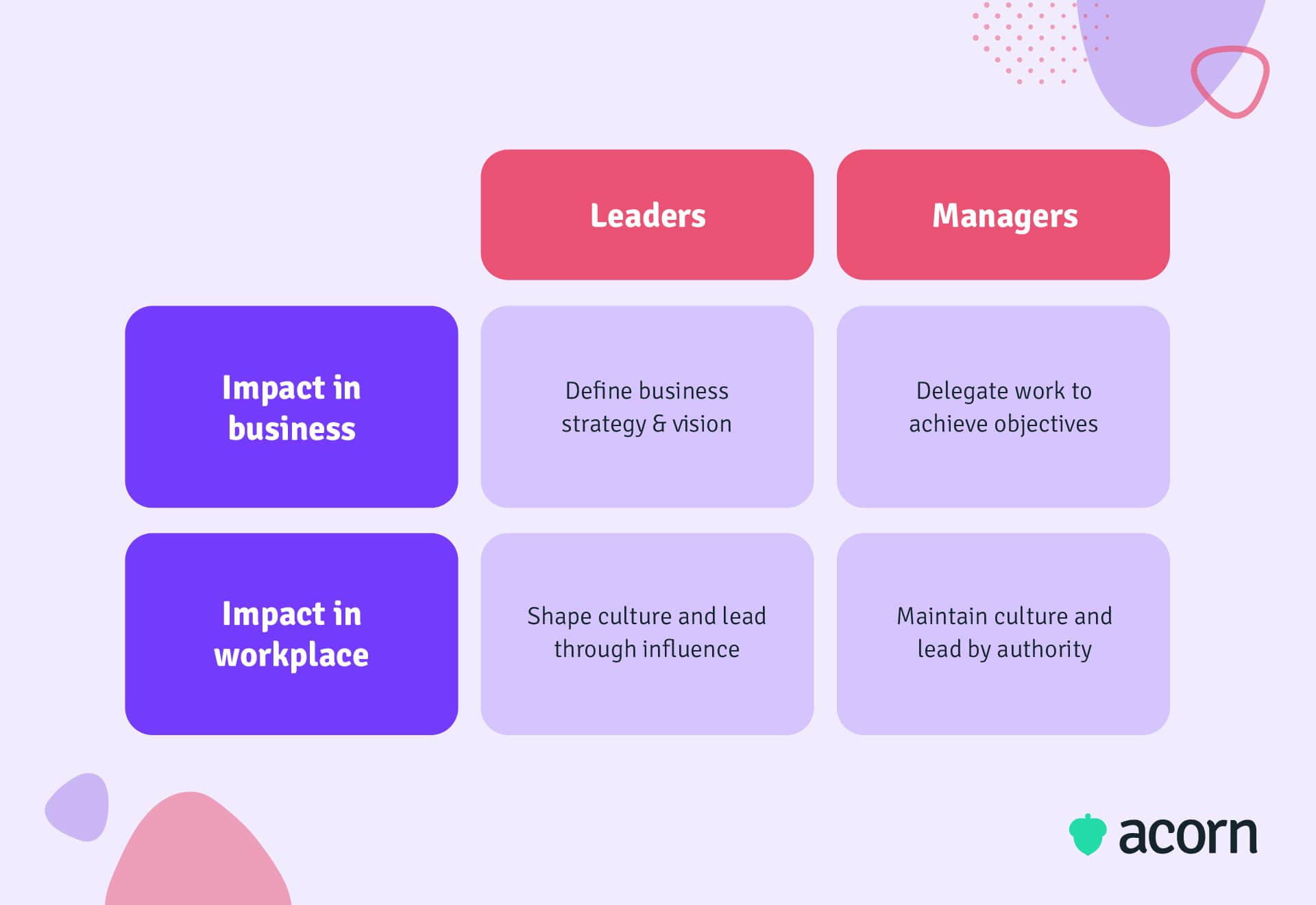
You’ll always have managers in your organisation, particularly in leadership teams. But if you truly want them to step up to the leadership plate, you need to measure and track leadership capabilities.
McKinsey notes it isn’t talent or one single skillset that is key to successful leadership. Neither would support your organisation in the way it needs to succeed, because it limits employees to a single career pathway instead of empowering them to explore strengths in different areas. This diminishes your internal talent pool and potentially alienates prospective talent.
Rather, having a variety of leaders of who excel in a few key capabilities is the fastest path to business growth. So, managing leadership capability serves two purposes:
- It helps develop promising and top talent in your organisation; and
- It ensures you have a diverse range in capabilities relating to business objectives at any one time.
Why do you need to align L&D with leadership capabilities?
Traditional L&D focuses on delivering a plethora of learning content to cover a broad range of compliance and technical skills needs. There’s nothing wrong with this, but as thought leader Josh Bersin says, the problems most organisations now face are not around technical skills. It’s the complex, soft, social and behavioural skills that are leading the charge. Young workers are curious about influence, problem-solving, communication and, you guessed it, leadership.
So, aligning L&D with a leadership capability framework differs from L&D that isn’t informed by business strategy (a rarity, we’ll admit) as it is owned by business leaders (not L&D or HR) who decide what capabilities are crucial. Rather than employees thinking, “Oh no, it’s that time of the year where I have to do my compulsory training”, L&D can become a self-motivated process that’s tied to attaining certain capabilities for career progression. It’s not just about advancing knowledge, but building capabilities at scale to ensure your workforce can perform, innovate and progress in strategic business areas.
Where leadership capability frameworks fit with other business strategies
We know why it’s important—but what sets a leadership capability framework apart from other strategic business staples?
Think of the big names leading the pack in innovation, market share or customer loyalty. Most wouldn’t say that the key to Apple’s pull is how many layers of management they have. Nor would you hear that people admire Microsoft’s leadership structures. As for Starbucks, well, most might just say they know how to give the people what they want in sugary drink form. But for innovation, market share and customer loyalty to even be achieved, they need to be quantified as certain capabilities in Apple, Microsoft and Starbucks’s employees.
Capabilities, as we know, are often seen as intangible as they aren’t easily replicable. But this isn’t quite right. They actually represent the alignment between people, resources and processes, being found in nigh but every leading and disruptive company—as are effective and inspiring leaders.
Leadership capabilities go a step further to define what good leadership looks like to a particular organisation. Ergo, leadership capability frameworks should have the following characteristics:
- Broad enough to cover all skills, attributes and knowledge.
- Enough depth to accurately assess behaviours.
- Clear and comprehensive but not contrived or prescriptive.
- Proprietary to your organisation.
- The characteristics of successful skill development.
But what just makes leadership capability frameworks distinct from other tools in your organisation toolkit?
Leadership capability frameworks vs capability frameworks
A capability framework is a separate but complementary and equally crucial entity. A regular, ol’ capability framework is normally broken down by job role or job family, defining what knowledge, skills and abilities are fundamentally important to a role. This makes a capability framework an astute tool of recruitment, performance management and career planning.
A capability framework’s leadership counterpart serves almost the same purpose, but for, you guessed it, management roles. Senior leaders are held accountable to ensuring the delivery of business outcomes. They are the tie between day-to-day projects and business strategies, they maintain culture and they inspire action in peers. Organisations without leadership frameworks tend to find the jump from top level business strategy to execution at an individual contributor level much harder.
Should we implement a leadership capability framework or a capability framework?
In short, you should implement both. Both are ongoing practices (i.e. not just one-off exercises) and both help guide learning and development programs. The difference is where and for who they could be applicable.
- Capability frameworks can be used by team leaders as part of performance management.
- HR often use capability frameworks for talent management, recruitment and internal mobility, for example, aligning noted capabilities with crisis teams or lacking capabilities against eLearning.
- Leadership capability frameworks help define what skills potential leaders need to develop, if succession planning can be done internally or whether external hires need to be made, and for identifying and promoting talent.
- It’s also a handy way to discern the superstar individual contributors who have the chops to become great people managers from those who are simply great team players—which can be hard at any point, but especially at the growth stage for an organisation.
Leadership capability frameworks vs role descriptions
A role description typically provides information for job seekers to evaluate their skills against expectations and decide if they are interested in applying. They’re often “candidate friendly” in that they are the first touchpoint between a prospect and your company. On the other hand, a leadership framework doesn’t describe the specific functions or responsibilities of senior executives or managers. Its purpose is to create a shared picture of success and effective performance. Their shared characteristic is their use as a point of reference in performance management.
Should we utilise a leadership capability framework or role descriptions in performance management?
Again, both play their part—though leadership capability frameworks may just win out on this one. The first critical element of performance management is the job description; after all, it literally describes what is expected of a person in a particular role. Accurate role descriptions give precedent given they often incorporate capabilities, which is both handy and where its benefits end.
A leadership framework establishes both a baseline (or precedent) and gives guidance for aspiring and existing leaders. As frameworks are usually outlined by levels of proficiency, it can used to validate succession choices, L&D programs or align with employee’s career aspirations in performance reviews.
How to develop a leadership capability framework for your business
It’s a three-step process:
- Refine business goals
- Audit your existing leadership
- Decide key leadership capabilities.
Step 1: Refine business priorities
You may already have these in writing, which is great. But if you haven’t looked at your business priorities in over a year, now’s the time to regroup. Succinctly put: If you don’t know what you’re doing and why you’re doing it, then you can’t have the how.
Businesses change and grow, and you may have already achieved previously set goals. Reflecting on success is just as important (if not more so) than pinpointing failures. If you can figure out what drove any successes, you’ll be better able to define the capabilities you need in key leadership.
Some potential avenues to consider here include:
- What projects were successful in that time, how were they managed and by who?
- How was recruitment handled? Were subject matter experts brought on board? Perhaps thought leaders? How about just those with great potential?
- Did you pick up new clients or customers?
- Did you explore new directions for growth, such as partnerships?
- What practices and attitudes were raised in exit interviews?
- Did professional development play a role in helping your workforce succeed?
Using this information as jumping off point for creating a new business plan (or simply reworking your current one) not only clarifies company direction, but ensures that key leaders are working from the same ideas and towards the same bigger picture.
Step 2: Conduct a capability audit
…or, in layman’s terms, assess your current workforce against your business goals. The purpose of this step is to identify the characteristics that are critical for leaders. You could use an existing map to refine generic capabilities, like the one below, or you could interview key personnel involved in hiring and talent decisions.
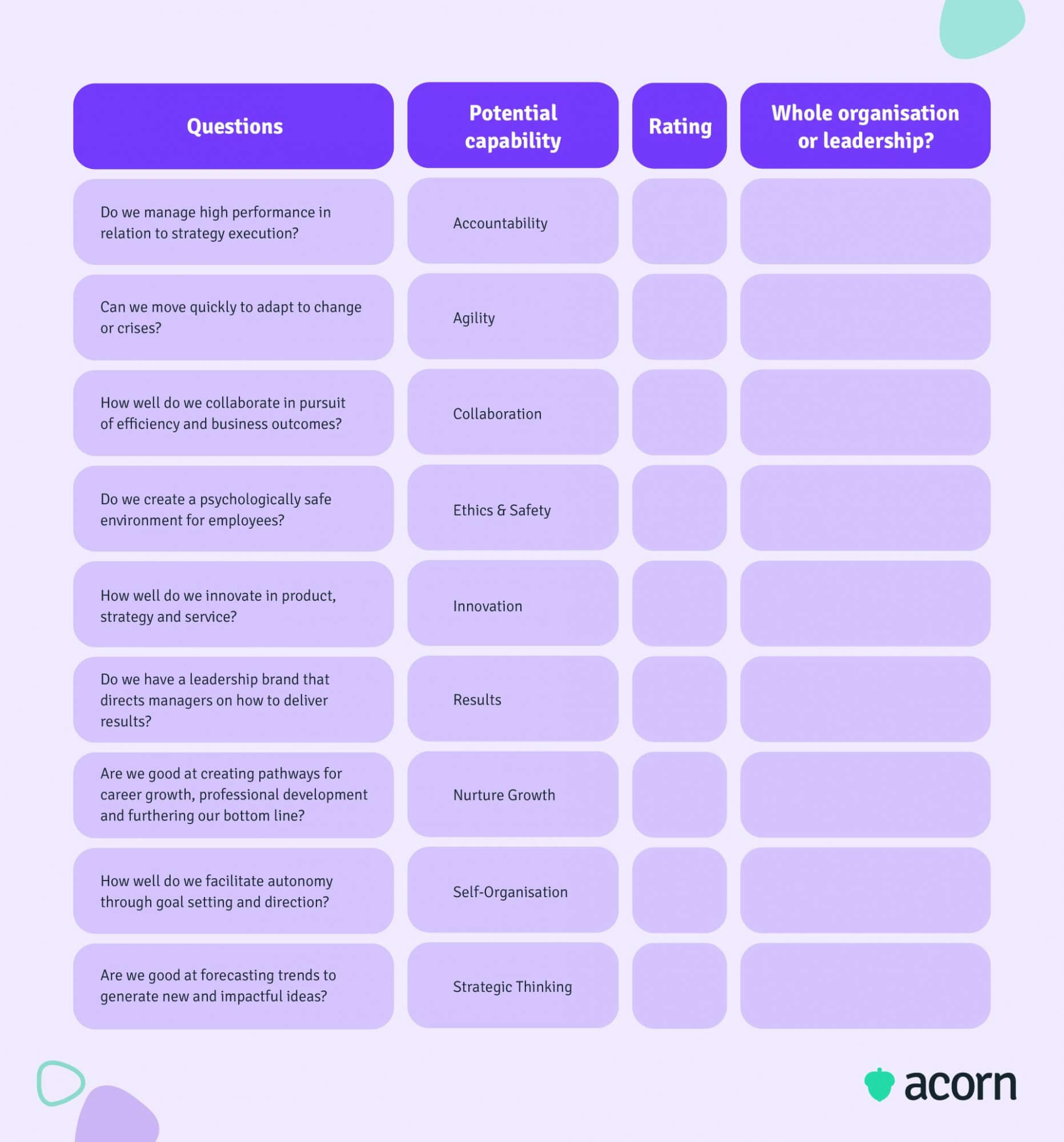
Understanding how and why people are promoted to or hired for leadership positions in your organisation will help paint a full picture. Explore considerations such as:
- Desirable behaviours
- Levels of experience, and how that is judged
- Peer reviews/reputation amongst peers
- Current/past projects
- Hires made through referrals
- Weight given to qualifications.
The idea is not to necessarily identify only weak or strong capabilities in your leadership, but to build a list of behaviours, experiences, skills and abilities that are expected of leadership as defined by the people in your organisation. It’s also handy to survey team players at this stage, as they can elaborate on what they want out someone leading them.
Step 3: Decide key leadership capabilities
Leaders often set the values, culture and goals for an organisation, too, so if leaders go off course, organisations follow. This is where you define the core capabilities leaders need to drive business outcomes. Remember: What makes a leader effective, strong or just plain “good” is unique to your organisation.
Something to note is that it can be easy to want to place emphasis on “hard” capabilities. Similar to hard skills, this can be things like change management and stakeholder engagement. As leaders are your agents of change, traditionally “soft” capabilities like communication, strategic thinking and the ability nurture others’ potential are just as important.
Whatever you name them, your leadership capabilities should be derived from business goals and values.

Below are some of our picks for basic capabilities (both “hard” and “soft”) research has shown great leaders display.
Ethics & standards
This is a two-parter. It encompasses leaders:
- Holding themselves accountable
- Creating a sense of safety for others.
Together, these attributes convey fairness, instil confidence and set the bar for others’ behaviour. A psychologically safe environment is important for helping employees perform their best and fostering healthy relationships, creativity and drive.
This particular capability is about having leaders who embody their own values as much as your organisation’s. It’s important in how they talk to others; say something went wrong in a project and it was the result of an employee’s mistake. There’s a difference between a leader saying, “You messed up,” and “I’m not blaming you. I’d like to know what happened.” Equally, if problem resolution escalates above said leader, will that leader take accountability or place the blame on the person who made the mistake?
Nurtures growth
A great leader leads. They know that success isn’t a zero-sum game, making helping others self-manage their time and workload a key part of leadership. Equally, it’s important for a leader to know when someone can do something better than them. The reason many strong individual contributors don’t make strong people managers is because they lack the ability to manage others’ emotional and development needs. A good leader is able to tie individual work to a greater goal and sustain it to meet deadlines.
This gets harder across generations, too, because it’s often subconsciously easier to communicate with people your own age. Effective leaders invest time in investigating talent horizons and taking the chance to learn from others as much as they facilitate opportunities for others to learn.
Cultural intelligence
Now more than ever, workforce demographics are shifting rapidly thanks to remote work. Diversity brings many opportunities (innovation, perspective, expansion), but it can also create barriers if leaders and employees alike aren’t open to it. Fostering and driving a sense of connection and belonging amongst people goes a long way to being able to influence those people.
Did you know that scientists have found employees can be emotionally drained just by watching unpleasant interactions between coworkers? Honest, open and frequent communication underpin your workplace culture. It’s a leader’s job to set the tone for their coworkers. The effects of a poor relationship really can ripple throughout culture, especially if hostility goes unchecked by management.
Thought leadership
Whatever their area of expertise, a leader should have expertise. Like we said earlier, you want leaders who bring a variety of strengths to match your organisation’s goals. Your managers don’t necessarily have to be thought leaders, but it certainly helps, even if they are simply viewed so by their peers and team. Why so?
- It gives weight to your brand reputation
- It adds to your employee value proposition for recruitment
- It fosters a collaborative, knowledge-sharing culture
- It gives existing employees something to aspire to, as well as a knowledgeable leader to turn to.
On another note, in order to provide the best advice or build innovative strategies, leaders need to be able to scan the horizon for emerging trends, opportunities and challenges.
Deliver results
Senior leadership is usually responsible for the delivery of complex projects. Under this umbrella comes technology and the ability to harness it improve outcomes. Implementing methodologies goes beyond writing a to-do list; leaders see the long-term value in repetition and trial-and-error. Setting project agendas or working to improve strategy isn’t something all employees can do or are even aware of. Providing feedback or guidance, regularly checking in and putting out fires as they arise is all part of ensuring multiple individual contributors are on track for a certain outcome.
Parting thoughts: It pays to develop a leadership capability framework
Where a capability framework drives your talent choices and gives all employees a better understanding of their contributions to company goals, and other tools like a leadership capability model enables you to nurture emerging talent, a capability framework for leaders outlines what “good” leadership looks like in your organisation. That is: What makes a leader influential, motivational and a key contributor to your bottom line.
As external forces storm or blow over, it’s important to have a solid internal foundation to weather environmental changes and continue to drive business growth. Where you need to promote internally, you can view a leadership framework as a map for developing a talent pipeline.
It gives you a basis for:
- Professional development
- Talent and performance management
- Succession planning
- Recruitment
- Assessing potential
- Giving strategic weight to L&D.
While you may be tempted to think, we already have strategies in place to help with talent and people management (like a standard capability framework) and recruitment and performance evaluation (role descriptions), a leadership capability framework stands on its own two legs.
Building one for your business gives you the advantages of:
- Revisiting business priorities (and celebrating successes while planning bigger goals);
- Conducting a capability audit (to help understand what skills and knowledge are actually crucial); and
- Defining the key leadership capabilities that underpin a healthy and motivated workplace culture, which ultimately propels your business goals.
Much like its sister the capability framework, leadership capabilities should be derived from business values, goals and strengths. Defining core competencies such as thought leadership, cultural intelligence and strong ethics gives your entire organisation an achievable, not just aspirational, measure of effective leadership.
Related Reads on This Topic

How to Design Leadership Training Courses That Impact Business Outcomes
Leadership training is not just about padding your talent bench. It’s an exercise in achieving business goals through core capabilities…

Opinion Piece: L&D and the Correlation-Causation Fallacy
Correlation shouldn’t be used to prove L&D ROI. Discover why causation is the key to showing impact and justifying decisions to executives…

The Step-by-Step Guide to Building Leadership Capability
Building leadership capability is essential to business success and succession planning. Read on to learn how you can build it…

